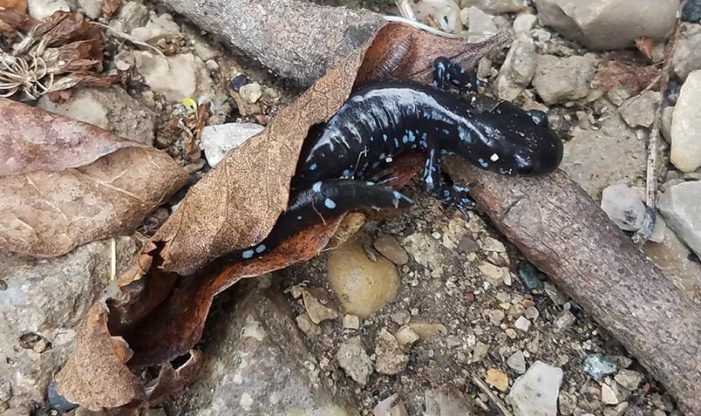One of the Center’s intriguing life forms is the blue-spotted salamander, a mole salamander which is native to the Great Lakes States, northeastern US, Quebec and Ontario. They’re common in Wisconsin, but urbanization and the filling in of wetlands have caused a decline. Blue-spotted salamanders have been the subject of observation by citizen scientists at Schlitz Audubon. Based on what volunteers have found, there is good news to share about this little creature and its significance to the Center.
Life Cycle of the Blue-spotted Salamander
Up to 14 cm in length, their skin is bluish-black. It has blue and white flecks on its back, and bluish-white spots on the sides of its body and tail. Blue-spotted salamanders are amphibians, which means they live a dual life. They spend part of their life in water and part of it on land. It is not known how long they live in the wild, but closely related species live as long as 10 years. They are born in ephemeral ponds, also called vernal ponds. These ponds exist temporarily, beginning in spring and then dry up at least partially in summer. Vernal ponds don’t support fish, which is good for blue-spotted salamanders because fish are a predator to them.
The salamander eggs hatch in spring, and by summer, the creatures transform into their terrestrial state. At this point, they leave the pond to dwell on land in the leaf litter of surrounding trees. Their diet includes invertebrates like worms and crunchy bugs. Blue-spotted salamanders always return to their home vernal pond each year to breed. By late spring, they return to land for the rest of the year. They are vernal pond obligates, meaning they can only use a vernal pond, not a permanent wetland body. The period of migration between land and their home pond is incredibly risky as they are more vulnerable to predators when they are on the move.
Importance of Salamanders
One of the reasons the blue-spotted salamanders are important is because they are indicator species. In general, salamanders are sensitive animals. They have thin, semipermeable skin that can absorb water and any toxins in their environment, so we don’t see them commonly near cities. However, during surveying in 2018, citizen scientists discovered something they had previously suspected, but not known for sure. Blue-spotted salamanders have breeding populations at Schlitz Audubon. In fact, they have one of the highest population count numbers for the citizen science survey in Milwaukee County.
This is good news. The Center’s habitat for salamanders is doing well. The ponds are clean enough to support them. And, the oak forests surrounding the ponds are plentiful enough to provide quality habitat during their land-dwelling phase. That’s why our conservation efforts are so important; removing invasive plant species and replenishing trees is good for their habitat.
Effects of a Changing Environment
Having a healthy habitat for blue-spotted salamanders ensures a good environment for other animals. They share their pond environment with eastern gray treefrogs, wood frogs, and many species of tadpoles. As part of our ravine restoration project, the Center added new ponds. Our citizen scientists have expanded their monitoring scope to encompass these ponds in order to understand how salamanders are adapting to new environments.
Another reason that understanding the blue-spotted salamander is important is the possibility of adding new species to the ponds they live in. By tracking the health of salamander populations, and by recording the presence of different aquatic invertebrates in our ponds, we can decide if we have suitable habitat to introduce other native salamander species to the property. Species we might consider are the eastern tiger salamander or spotted salamander.
We will continue to watch the blue-spotted salamander population and maintain their quality habitat. It’s exciting to know that each of the hundreds of salamanders that exist in our current ponds have successfully metamorphosed there and will return annually to lay their own eggs.
This post was updated on March 28, 2025.


